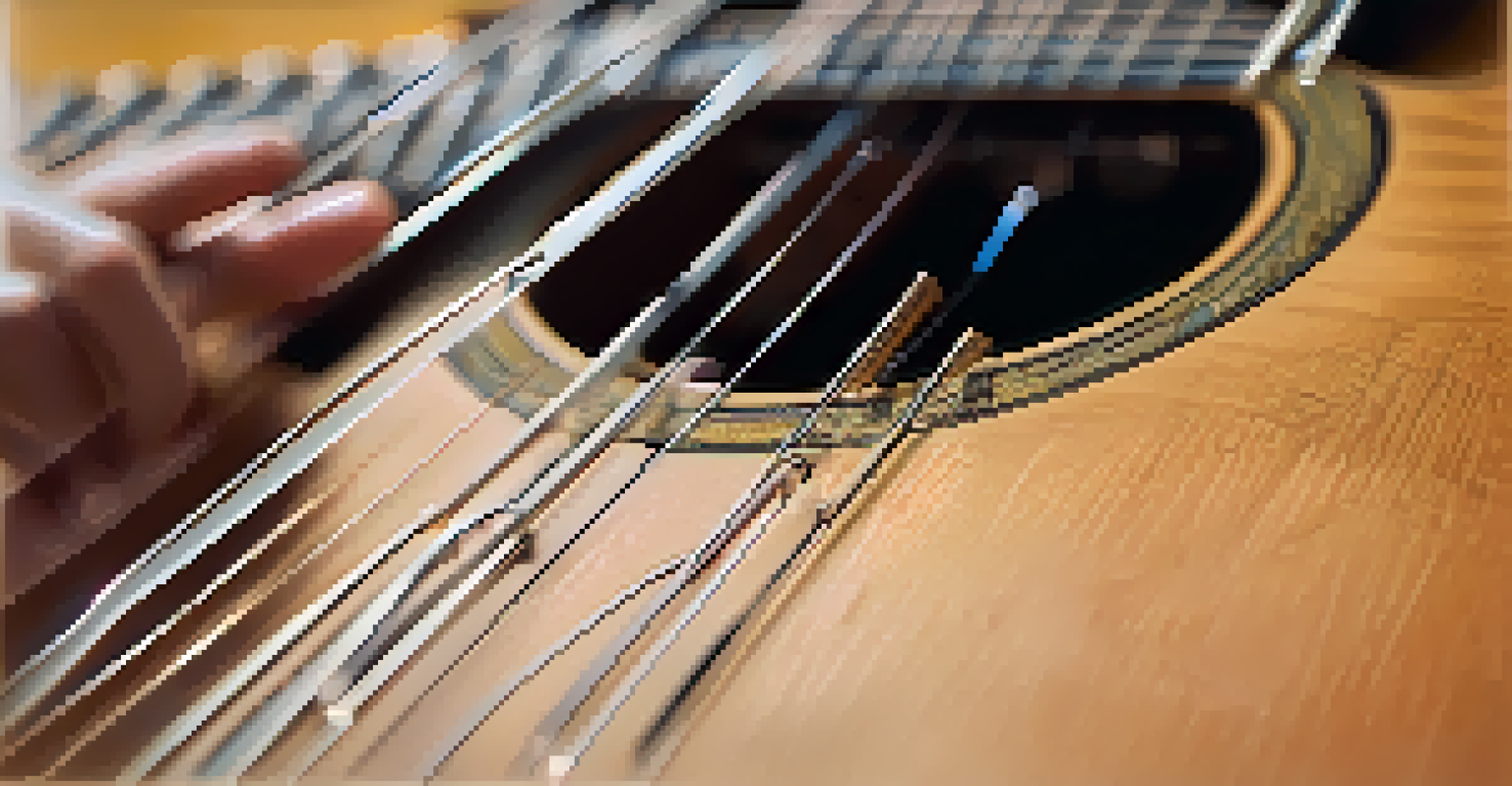Creating Unique Chord Progressions on Guitar

Understanding the Basics of Chord Progressions
Before diving into unique chord progressions, it's essential to understand what a chord progression is. Essentially, it's a sequence of chords played in succession, forming the foundation of a song. Most popular songs use common progressions, which can be a great starting point for beginners looking to grasp the concept.
Music is the shorthand of emotion.
Familiarizing yourself with basic chords, such as major, minor, and seventh chords, can help you appreciate how they work together. For instance, the I-IV-V progression (C-F-G in the key of C) is a classic example that many songs are built upon. Understanding these relationships will make it easier to experiment later on.
Once you have the basics down, you'll start to notice patterns in songs you love. This awareness will inspire you to create your own progressions, allowing your musical creativity to flourish while still relying on established structures.
Experimenting with Chord Inversions
Chord inversions can breathe new life into your progressions and make them sound unique. An inversion occurs when the notes of a chord are rearranged, changing the bass note while keeping the chord's overall sound intact. For example, playing a C major chord in its first inversion (E-G-C) can provide a fresh perspective.

Using inversions allows you to create smoother transitions between chords. Instead of jumping from one chord to another, you can often find a more melodic way to connect them by altering their voicings. This can make your progressions feel more fluid and natural.
Understand Chord Progressions
A chord progression is a sequence of chords that forms the foundation of a song, with common patterns offering a great starting point for beginners.
Try incorporating various inversions into your existing progressions. You might be surprised by how a simple change in the bass note can evoke an entirely different emotion, enhancing the overall character of your music.
Incorporating Non-Diatonic Chords
Non-diatonic chords are chords that don't belong to the key you're working in, and they can add unexpected flavors to your progressions. For instance, if you’re in the key of C, adding an F# major chord can create a surprising twist. This technique can help you step outside the confines of predictable progressions.
The only thing better than singing is more singing.
One effective way to use non-diatonic chords is to create tension before resolving back to diatonic chords. This tension can make your music more engaging and dynamic, keeping listeners on their toes. Think of it like adding spice to a dish; a little goes a long way in enhancing overall flavor.
Experimenting with non-diatonic chords can lead to exciting discoveries in your songwriting. Start by identifying a few key chords that intrigue you, then try to incorporate them into your progressions, even if it feels unconventional.
Utilizing Modal Interchange for Variety
Modal interchange is a technique where you borrow chords from a parallel mode, allowing you to diversify your progressions. For example, if you're in C major, you can borrow chords from C minor, such as Bb major or Ab major. This can create a richer harmonic palette in your music.
When using modal interchange, think about how the borrowed chords can complement your existing progressions. They can introduce new moods and colors, transforming a straightforward progression into something more complex and intriguing. It's like painting with a broader spectrum of colors.
Experiment with Inversions
Using chord inversions can create smoother transitions and add a unique flair to your progressions by changing the bass note.
As you explore modal interchange, don't hesitate to experiment with different modes. Each mode has its own unique flavor, and learning how to incorporate them can significantly enhance your songwriting arsenal.
Creating Suspense with Extended Chords
Extended chords, like ninths, elevenths, and thirteenths, can add depth and complexity to your progressions. These chords include extra notes that enhance the harmonic richness, creating a sense of suspense. For instance, a Cmaj7 chord (C-E-G-B) has a more sophisticated sound than a standard C major chord.
By incorporating extended chords into your progressions, you can evoke a wide range of emotions. They often add a touch of jazz or sophistication to your music, making it stand out. Think of them as the secret ingredient in a recipe that elevates the entire dish.
Don't be afraid to mix extended chords with simpler ones. This contrast can create a beautiful tension that keeps listeners engaged, making your music memorable and distinct.
Using Rhythm to Enhance Your Progressions
While harmony is crucial, rhythm plays a significant role in how your progressions are perceived. Varying the strumming pattern or the timing of your chords can dramatically alter the feel of your music. For example, playing a progression in a syncopated rhythm can make it feel more lively and energetic.
Consider how different rhythms can complement your chord choices. A slow ballad may benefit from a steady, flowing rhythm, while an upbeat track can thrive on syncopation or off-beat accents. This relationship between rhythm and harmony is where the magic happens.
Incorporate Extended Chords
Extended chords add depth and complexity to your music, enhancing emotional expression and creating memorable progressions.
Experiment with various rhythmic patterns and see how they interact with your progressions. You might find that a new rhythm brings out the best in your chords, unlocking fresh possibilities for your songwriting.
Finding Inspiration from Other Genres
One of the best ways to develop unique chord progressions is to draw inspiration from different musical genres. Each genre has its own characteristic progressions and styles, and blending elements can lead to exciting results. For instance, infusing some jazz chords into a pop song can create a fresh sound.
Listening to a variety of music can open your mind to new possibilities. Pay attention to how different artists structure their chords and how they create tension and release. This exploration can spark your creativity and lead to unique progressions that reflect your musical identity.

So, don't hesitate to step outside your comfort zone and explore genres you might not typically listen to. You may discover new techniques and ideas that inspire your next songwriting session.